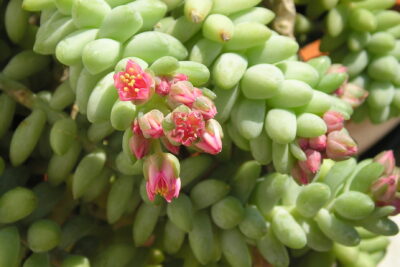
Exploring the Beauty of Sedum Sunset Succulent: A Comprehensive Guide

Sedum Sunset is a popular succulent plant known for its stunning beauty and versatility. With its vibrant colors and unique foliage, it has become a favorite among plant enthusiasts and gardeners alike. This hardy plant is not only visually appealing but also easy to care for, making it a great addition to any indoor or outdoor space.
In this comprehensive guide, we will delve into the world of Sedum Sunset succulents, exploring their origins, characteristics, and care requirements. We will discuss the various types and varieties available, as well as tips for propagation and maintenance. Whether you are a seasoned succulent lover or a beginner looking to add some greenery to your home, this article will provide you with all the information you need to cultivate and enjoy the beauty of Sedum Sunset succulents.
- Learn about the ideal growing conditions for Sedum Sunset succulent
- Provide ample sunlight for your Sedum Sunset succulent to thrive
- Water your Sedum Sunset succulent sparingly to avoid overwatering
- Use well-draining soil to prevent root rot in Sedum Sunset succulent
- Propagate Sedum Sunset succulent by stem cuttings or leaf cuttings
- Prune Sedum Sunset succulent to maintain its shape and promote new growth
- Protect Sedum Sunset succulent from frost and extreme temperatures
- Watch out for common pests and diseases that can affect Sedum Sunset succulent
- Enjoy the stunning foliage and flowers of Sedum Sunset succulent in your garden or as a houseplant
- Frequently Asked Questions
Learn about the ideal growing conditions for Sedum Sunset succulent
If you're a succulent enthusiast looking to add a touch of vibrant color to your collection, Sedum Sunset succulent is the perfect choice. This stunning plant, also known as Sedum adolphii 'Sunset', is renowned for its captivating orange and red hues, making it a popular choice among succulent lovers.
However, to ensure the optimal growth and health of your Sedum Sunset succulent, it's crucial to provide it with the ideal growing conditions. Here's a comprehensive guide to help you create the perfect environment for this mesmerizing succulent:
1. Sunlight:
Sedum Sunset succulents thrive in bright, indirect sunlight. Place them in a location where they can receive at least six hours of sunlight each day. However, be cautious of intense, direct sunlight, as it can cause the leaves to burn. If you notice signs of scorching, consider providing some shade during the hottest parts of the day.
2. Temperature:
These succulents prefer warm temperatures ranging from 65°F to 80°F (18°C to 27°C). Avoid exposing them to temperatures below 50°F (10°C) as it can lead to frost damage and potentially kill the plant.
 Black Beauty: A Guide to Succulents with Stunning Black Leaves
Black Beauty: A Guide to Succulents with Stunning Black Leaves3. Watering:
Sedum Sunset succulents are drought-tolerant and have low water requirements. Water your plant thoroughly, allowing the soil to dry out completely between waterings. Overwatering can cause root rot and other issues, so it's better to underwater than to overwater.
4. Soil:
These succulents prefer well-draining soil that allows excess water to pass through easily. A mix of succulent or cactus potting soil, combined with perlite or sand, creates the perfect soil composition. This combination ensures proper drainage, preventing waterlogged roots.
5. Fertilizer:
During the active growing season, which is typically spring and summer, you can fertilize your Sedum Sunset succulent once a month. Use a balanced, diluted succulent fertilizer to provide the necessary nutrients. However, refrain from fertilizing during the dormant winter months.
6. Propagation:
Sedum Sunset succulents are relatively easy to propagate. You can propagate them using stem cuttings or by detaching the offsets that grow around the base of the plant. Allow the cuttings or offsets to callus for a few days before planting them in well-draining soil.
By following these guidelines and providing the ideal growing conditions, you can enjoy the beauty of Sedum Sunset succulent in all its glory. Its vibrant colors and low-maintenance nature make it a fantastic addition to any succulent collection.
Provide ample sunlight for your Sedum Sunset succulent to thrive
Sedum Sunset succulents thrive in bright sunlight. It is important to provide ample sunlight to ensure their healthy growth. Place your Sedum Sunset succulent in an area where it can receive at least 6 hours of direct sunlight each day. This will help the succulent maintain its vibrant colors and compact shape.
 Best Trailing Succulents: Explore Our Top Picks for Cascading Beauty
Best Trailing Succulents: Explore Our Top Picks for Cascading BeautyIf you are growing Sedum Sunset succulents indoors, place them near a south-facing window where they can receive the most sunlight. You may also consider using a grow light to supplement the natural light if necessary.
Remember, sunlight is essential for the photosynthesis process in plants, and Sedum Sunset succulents are no exception. Providing sufficient sunlight will not only promote their growth but also enhance their overall beauty.
It is important to note that while Sedum Sunset succulents love sunlight, they can also tolerate partial shade. If you live in an area with intense summer heat, you may want to provide them with some afternoon shade to protect them from scorching.
Overall, ensuring ample sunlight is one of the key factors in successfully growing Sedum Sunset succulents.
Water your Sedum Sunset succulent sparingly to avoid overwatering
One of the most important aspects of caring for your Sedum Sunset succulent is proper watering. These succulents are native to arid regions and have adapted to thrive in dry conditions. Overwatering can easily lead to root rot and other issues, so it's important to be mindful of your watering routine.
When it comes to watering your Sedum Sunset succulent, less is definitely more. These plants prefer to be slightly underwatered rather than overwatered. A good rule of thumb is to wait until the soil is completely dry before watering again. You can test the moisture level by sticking your finger about an inch into the soil – if it feels dry, it's time to water.
 Succulents: Annuals or Perennials in Their Natural Habitat?
Succulents: Annuals or Perennials in Their Natural Habitat?When watering, make sure to do so thoroughly. Give your Sedum Sunset succulent a good soak, allowing the water to fully penetrate the soil. However, be cautious not to leave the plant sitting in standing water, as this can lead to root rot. Always empty any excess water from the saucer or tray beneath the pot.
During the warmer months, when the succulent is actively growing, you can water more frequently. However, during the colder months or when the plant is in a dormant state, you should reduce the frequency of watering. Remember, it's better to underwater than overwater.
Another important consideration is the type of water you use. Sedum Sunset succulents are sensitive to minerals and chemicals found in tap water, so it's best to use filtered or distilled water. Alternatively, you can collect rainwater and use it for watering your succulent.
By following these watering guidelines, you can ensure that your Sedum Sunset succulent remains healthy and vibrant. Remember, a little goes a long way when it comes to watering these beautiful plants!
Use well-draining soil to prevent root rot in Sedum Sunset succulent
The Sedum Sunset succulent, also known as Sedum adolphii 'Sunset', is a stunning plant that can add a pop of color to any garden or indoor space. With its vibrant orange and yellow leaves, it is no wonder why this succulent is a favorite among plant enthusiasts.
When it comes to caring for your Sedum Sunset succulent, one crucial aspect to consider is the type of soil you use. This succulent thrives in well-draining soil, as it helps prevent root rot, a common issue that can be detrimental to the health of your plant.
 Low-Maintenance Plants with Succulent-Like Care and Appearance
Low-Maintenance Plants with Succulent-Like Care and AppearanceRoot rot occurs when the roots of a plant are constantly sitting in waterlogged soil, leading to the roots becoming mushy and eventually dying. This condition can be caused by overwatering or using soil that does not drain well.
To ensure your Sedum Sunset succulent stays healthy and vibrant, it is essential to use well-draining soil. This type of soil allows excess water to flow through, preventing water from pooling around the roots.
To create a well-draining soil mix for your Sedum Sunset succulent, you can combine regular potting soil with perlite or pumice. These additives help create air pockets in the soil, allowing water to drain more effectively.
When repotting your Sedum Sunset succulent, make sure to choose a pot with drainage holes at the bottom. This allows excess water to escape, further preventing the risk of root rot.
Remember to water your Sedum Sunset succulent sparingly and only when the top inch of soil is dry. Overwatering can quickly lead to root rot, so it is crucial to monitor the moisture levels of the soil.
By using well-draining soil and practicing proper watering techniques, you can ensure that your Sedum Sunset succulent thrives and continues to display its stunning colors for years to come.
Propagate Sedum Sunset succulent by stem cuttings or leaf cuttings
 Discover Fred Ives' Top Recommended Succulent Varieties for Your Home
Discover Fred Ives' Top Recommended Succulent Varieties for Your HomePropagating Sedum Sunset succulent is a rewarding and cost-effective way to expand your collection. This beautiful succulent can be easily propagated using either stem cuttings or leaf cuttings.
Stem Cuttings
To propagate Sedum Sunset succulent through stem cuttings, follow these simple steps:
- Choose a healthy stem from the mother plant. Make sure it is free from any signs of disease or damage.
- Using a clean and sharp pair of scissors or gardening shears, cut a 4-6 inch section of the stem.
- Remove the lower leaves from the stem, leaving a few at the top intact.
- Allow the cut end to dry for a day or two. This will help prevent rotting when planted.
- Prepare a well-draining potting mix suitable for succulents.
- Insert the cut end of the stem into the potting mix, burying it about an inch deep.
- Water the newly planted cutting lightly, ensuring the soil is moist but not waterlogged.
- Place the pot in a bright location, away from direct sunlight.
- Keep the soil consistently moist until roots develop, usually within a few weeks.
- Once the cutting has established roots, you can transplant it into a larger pot or your desired location.
Leaf Cuttings
If you prefer to propagate Sedum Sunset succulent using leaf cuttings, here's what you need to do:
- Select healthy leaves from the mother plant, making sure they are plump and free from any damage.
- Gently twist the leaves from the stem, ensuring that a clean break occurs.
- Allow the leaf cuttings to dry for a couple of days, or until calluses form at the base of the leaves.
- Prepare a well-draining potting mix suitable for succulents.
- Place the callused end of the leaf cutting into the potting mix, burying it slightly.
- Mist the soil lightly, keeping it moist but not overly wet.
- Keep the pot in a warm and bright location, but avoid direct sunlight.
- Within a few weeks, you should start to notice new growth emerging from the base of the leaf.
- Once the new plantlet has developed roots, you can transplant it into a separate pot or desired location.
Note: It's important to remember that propagating succulents can take time and patience. Not every cutting or leaf will successfully root and grow into a new plant. However, with proper care and the right conditions, you can increase your chances of success.
Prune Sedum Sunset succulent to maintain its shape and promote new growth
Pruning is an essential task when it comes to caring for your Sedum Sunset succulent. By regularly pruning this beautiful plant, you can not only maintain its shape but also stimulate new growth and ensure its overall health and vitality.
When pruning Sedum Sunset succulent, it's important to follow a few guidelines to achieve the best results. Here are some tips to help you get started:
 Discover the Perfect Sedum Variety for a Vibrant Blue Succulent
Discover the Perfect Sedum Variety for a Vibrant Blue Succulent1. Choose the Right Time
Pruning should ideally be done during the active growing season, which is typically spring or early summer. This allows the plant to recover quickly and encourages healthy new growth.
2. Gather Your Tools
Before you begin pruning, make sure you have the necessary tools on hand. A pair of sharp, clean pruning shears or scissors will be your best friends for this task. Ensure that your tools are disinfected to prevent the spread of any potential diseases.
3. Identify the Areas to Prune
Take a close look at your Sedum Sunset succulent and identify any areas that need pruning. Look for leggy or overgrown stems, damaged or diseased parts, or any sections that are blocking light from reaching other parts of the plant.
4. Cut with Precision
When making cuts, it's important to do so with precision. Locate a node, which is where a leaf or branch is attached to the stem, and make your cut just above it. This encourages new growth to emerge from that point.
5. Dispose of Pruned Material
After pruning, be sure to dispose of the pruned material properly. Remove any diseased or damaged parts from the vicinity of the plant to prevent the spread of infections. You can either compost the healthy pruned material or discard it in the trash.
6. Monitor and Care for your Sedum Sunset Succulent
After pruning, keep a close eye on your Sedum Sunset succulent. Ensure that it receives adequate sunlight, water, and proper care to support its growth and recovery. Regularly check for any signs of pests or diseases and take immediate action if needed.
By following these pruning tips, you can help your Sedum Sunset succulent thrive and maintain its stunning shape. Don't be afraid to trim it back when necessary, as it will reward you with fresh growth and a more compact form.
 Discover the tallest succulent tree species for your garden
Discover the tallest succulent tree species for your gardenProtect Sedum Sunset succulent from frost and extreme temperatures
Sedum Sunset succulent is a stunning plant that adds a touch of beauty to any garden or indoor space. However, it is important to take proper care of this succulent to ensure its longevity. One crucial aspect of caring for Sedum Sunset succulent is protecting it from frost and extreme temperatures.
Frost can be detrimental to the health of Sedum Sunset succulent, causing its leaves to turn brown and eventually die. To prevent frost damage, it is recommended to bring the succulent indoors or provide it with cover during the colder months. You can also consider using frost cloth or burlap to protect the plant from freezing temperatures.
Extreme temperatures, both hot and cold, can also pose a threat to Sedum Sunset succulent. Too much heat can cause the plant to wilt and become dehydrated, while extreme cold can lead to frost damage as mentioned earlier. It is important to keep an eye on the weather conditions and take necessary precautions to shield the succulent from temperature extremes.
In addition to protecting Sedum Sunset succulent from frost and extreme temperatures, it is essential to provide it with the right growing conditions. This succulent thrives in well-draining soil and requires ample sunlight to flourish. Ensure that the plant receives at least six hours of direct sunlight each day to promote healthy growth.
When it comes to watering Sedum Sunset succulent, it is important to strike a balance. Overwatering can lead to root rot and other issues, while underwatering can cause the leaves to shrivel and wilt. It is best to water the plant thoroughly, allowing the soil to dry out between waterings.
Furthermore, Sedum Sunset succulent benefits from occasional fertilization. Use a well-balanced fertilizer formulated for succulents and apply it according to the package instructions. Remember not to over-fertilize, as it can cause the plant to become leggy or suffer from nutrient burn.
 Discover the Top Orange Succulent Plants to Enhance Your Home
Discover the Top Orange Succulent Plants to Enhance Your HomeProper care and protection from frost and extreme temperatures are essential to maintain the beauty and health of Sedum Sunset succulent. By providing it with the right growing conditions, watering it appropriately, and shielding it from harsh weather conditions, you can enjoy the beauty of this succulent for years to come.
Watch out for common pests and diseases that can affect Sedum Sunset succulent
When it comes to caring for your Sedum Sunset succulent, it's important to be aware of common pests and diseases that can affect its health. By being proactive in preventing and addressing these issues, you can ensure that your succulent remains vibrant and beautiful.
Pests to look out for:
- Mealybugs: These small, cottony white insects are a common pest for succulents. They feed on the sap of the plant, causing damage and weakening its overall health. To get rid of mealybugs, you can use a cotton swab dipped in rubbing alcohol to remove them from the leaves and stems.
- Aphids: Aphids are tiny, soft-bodied insects that commonly infest succulents. They feed on the plant's sap and can cause stunted growth and yellowing of leaves. To eliminate aphids, you can use a mixture of water and mild dish soap to create a soapy solution. Spray this solution on the affected areas of the plant to kill the aphids.
- Spider mites: Spider mites are minuscule pests that are barely visible to the naked eye. They feed on the plant's juices, leaving behind tiny webs and causing damage to the leaves. To control spider mites, you can spray your succulent with a mixture of water and neem oil. This will suffocate the mites and prevent further infestation.
Common diseases that may affect Sedum Sunset succulent:
- Root rot: Overwatering or poor drainage can lead to root rot in succulents. This disease causes the roots to become mushy and black, ultimately leading to the death of the plant. To prevent root rot, ensure that your succulent is planted in well-draining soil and only water it when the top inch of soil is dry.
- Leaf spot: Leaf spot is a fungal disease that causes brown or black spots to appear on the leaves of the succulent. This disease thrives in humid conditions, so it's important to provide good air circulation and avoid overwatering. If leaf spot occurs, remove the affected leaves and ensure that the remaining foliage stays dry.
- Powdery mildew: Powdery mildew is a fungal infection that results in a white powdery substance appearing on the leaves of the succulent. This disease can be prevented by providing adequate air circulation and avoiding overhead watering. If powdery mildew is present, you can use a fungicide specifically formulated for succulents to control its spread.
By staying vigilant and taking proactive measures, you can prevent and address common pests and diseases that may affect your Sedum Sunset succulent. Remember to regularly inspect your plant for any signs of infestation or disease, and take appropriate action to keep your succulent thriving.
Enjoy the stunning foliage and flowers of Sedum Sunset succulent in your garden or as a houseplant
The Sedum Sunset succulent is a truly remarkable plant that can add a touch of beauty and elegance to any garden or indoor space. With its stunning foliage and vibrant flowers, this succulent is a must-have for plant enthusiasts and collectors.
Native to Mexico and Central America, Sedum Sunset is a member of the Crassulaceae family, which includes other popular succulents such as Echeveria and Crassula. This succulent is known for its ability to thrive in various conditions, making it a versatile choice for both experienced gardeners and beginners.
 Can Succulents Display Both Red and Purple Colors Simultaneously?
Can Succulents Display Both Red and Purple Colors Simultaneously?Features and Characteristics
Sedum Sunset succulent is a low-growing plant that forms rosettes of fleshy, elongated leaves. The leaves are typically green, but they can develop beautiful shades of red, yellow, or orange when exposed to sunlight or during the cooler months. This color transformation adds to the plant's visual appeal and makes it an excellent choice for adding contrast and interest to your garden or indoor space.
In addition to its foliage, Sedum Sunset produces clusters of small, star-shaped flowers in shades of pink, red, or white. These flowers bloom in late summer or early fall, attracting pollinators such as bees and butterflies. The combination of its colorful foliage and charming flowers makes Sedum Sunset a true showstopper.
Cultivation and Care
Sedum Sunset succulent is relatively easy to grow and care for, making it an excellent choice for beginners. Here are some key tips to ensure your Sedum Sunset thrives:
- Light: Sedum Sunset prefers bright, indirect sunlight. It can tolerate some direct sunlight, but too much can cause the leaves to burn.
- Watering: Allow the soil to dry out completely between waterings. Overwatering can lead to root rot, so it's crucial to practice moderation.
- Soil: Use a well-draining soil mix specifically formulated for succulents. This will help prevent waterlogged roots and promote healthy growth.
- Temperature: Sedum Sunset thrives in temperatures between 65°F and 75°F (18°C and 24°C). Protect it from frost and extreme heat.
- Fertilization: Feed your Sedum Sunset with a balanced, diluted fertilizer during the growing season (spring and summer).
With proper care and attention, your Sedum Sunset succulent will reward you with its stunning foliage and delightful flowers. Whether you choose to grow it in a garden bed, container, or as a houseplant, this succulent is sure to captivate anyone who sets their eyes on it.
Frequently Asked Questions
1. What is Sedum Sunset Succulent?
Sedum Sunset Succulent is a type of succulent plant known for its vibrant orange and red foliage. It is a popular choice for gardens and containers due to its striking color and low maintenance requirements.
2. How do I care for Sedum Sunset Succulent?
Sedum Sunset Succulent thrives in well-draining soil and requires full sun to maintain its vibrant color. It is a drought-tolerant plant and should be watered sparingly, allowing the soil to dry out between waterings. Avoid overwatering to prevent root rot.
3. Can Sedum Sunset Succulent tolerate cold temperatures?
Sedum Sunset Succulent is a hardy plant that can tolerate cold temperatures down to USDA hardiness zone 7. However, it is best to protect it from prolonged freezing temperatures to prevent damage to the foliage.
 Discover the Largest and Most Stunning Big Leaf Succulents
Discover the Largest and Most Stunning Big Leaf Succulents4. How can I propagate Sedum Sunset Succulent?
Sedum Sunset Succulent can be easily propagated through stem cuttings or by dividing the plant. Simply cut a healthy stem or separate the offsets from the mother plant, let them callus for a few days, and then plant them in well-draining soil. Keep the soil lightly moist until new roots develop.
If you want to read more articles similar to Exploring the Beauty of Sedum Sunset Succulent: A Comprehensive Guide, you can visit the Varieties and Colors category.






You Must Read